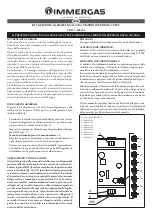
Part number 550-100-260/0520
97
ECO
®
Tec
G
AS
-
FIRED
WATER
BOILER
–
80/110/150/199
B
OILER
M
ANUAL
!NTIFREEZEAND#ORRECT$OSAGE!MOUNT
Use only antifreeze listed by Weil-McLain as suitable for use with
ECO
Tec
Gas Boilers. See Figure 125, page 137 for information
to obtain antifreeze through a Weil-McLain distributor.
1. Determine the freezing temperature needed (to protect
against lowest likely temperature the system water will
encounter).
2. Find the antifreeze concentration by volume needed for this
temperature from the antifreeze manufacturer’s data on the
antifreeze container.
3. Add up the volume (gallons) of all system piping and
components, including the expansion tank and boiler.
a. Boiler water content is listed in Figure 138, page 149.
b. Remember to include expansion tank water content.
4. Multiply this volume by the (percent) antifreeze needed to
find the number of gallons of antifreeze to add.
Fill and test water system
1. Fill system only after ensuring the water meets the
requirements of this manual.
2. Close manual and automatic air vents and boiler drain valve.
3. Fill to correct system pressure. Correct pressure will vary
with each application.
a. Typical cold water fill pressure for a residential system
is 12 psi.
b. Pressure will rise when boiler is turned on and system
water temperature increases. Operating pressure must
never exceed 24 PSIG.
4. For combi models only, purge domestic water up to cold water
inlet by flushing water out the drain valve (Figure 54, page 44,
Item #3). Once flushing is complete, allow water to flow
through boiler’s internal domestic water circuit by opening
a faucet. Ensure proper flow rate is obtained. If the flow
rate through several faucets seem reduced, remove and
clean internal combi filters located in the Domestic Water’s
Return Manifold; see page 134 under section
Cleaning &
Maintenance for Domestic Water Inlet Manifold
.
5. At initial fill and during boiler startup and testing, check
system thoroughly for any leaks. Repair all leaks before
proceeding further.
Eliminate all system leaks. Continual fresh make-
up water will reduce boiler life. Minerals can build
up in the heat exchanger, reducing heat transfer,
overheating heat exchanger, and causing heat
exchanger failure.
Purge air from water system
1. Connect a hose to the purge valve (see purge/drain valves,
Item 11, in piping diagrams beginning on page 44). Route
hose to an area where water can drain and be seen.
2. Close the boiler or system isolation valve between the purge
valve and fill connection to the system.
3. Close zone isolation valves.
4. Open quick-fill valve on cold water make-up line.
5. Open purge valve.
#LEANSYSTEMTOREMOVESEDIMENT
1. The system must be thoroughly flushed (without boiler
connected) to remove sediment. The high-efficiency heat
exchanger can be damaged by buildup or corrosion due to
sediment.
2. For zoned systems, flush each zone separately through a purge
valve. (If purge valves and isolation valves are not already
installed, install them to properly clean the system.)
3. Flush system until water runs clean and piping is free of
sediment.
Do not use petroleum-based cleaning
or sealing compounds in boiler system.
Damage to elastomer seals and gaskets in
system could occur, resulting in substantial
property damage.
Before filling the boiler and system with
water, verify the following.
DO NOT fill
with softened water.
Boiler corrosion can
occur.
Failure to comply could result in boiler
failure or unreliable operation.
Water chemistry
7ATERP(BETWEENAND
1. Maintain boiler water pH between 7.0 and 8.5. Check with
litmus paper or have chemically analyzed by water treatment
company.
2. If pH differs from above, consult local water treatment
company for treatment needed.
(ARDNESSLESSTHANGRAINS
1. Consult local water treatment companies for unusually hard
water areas (above 7 grains hardness).
#HLORIDECONCENTRATIONMUSTBE
,%334(!.PPM
1. Filling with chlorinated fresh water should be acceptable
since drinking water chloride levels are typically less than
5 ppm.
2. Do not use the boiler to directly heat swimming pool or
spa water.
3. Do not fill boiler or operate with water containing chloride
in excess of 200 ppm.
Verify that the water chemistry meets the limitations
and requirements of all other equipment in the
system.
Startup — fill the system
















































